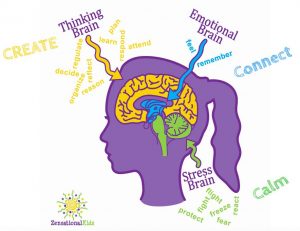Positive thinking Changes Behaviour
Part Two:
Why Positive Thinking effects Behaviour in a Positive Way.
Recent research and theory explains us why and how this works. All humans are part of networks. Our brains are interconnected; we influence but also are influenced by others as we are interconnected from the moment we are conceived. An infant’s brain is partly formed at birth by the relationship it has with its mother and father. A mother’s smile changes the chemistry in a baby’s brain and it elicits a response. We physically change each other through our interactions with each other….
How is this so?
All experience is stored in our brain.

Deep in the middle of our brain, in the limbic system. Experiences are stored as memories, in a part of the limbic system called the Hippocampus. The Hippocampus is adjacent to another very important part of the brain called Amygdala, the part responsible for basic emotions: fear, anger, pleasure, shame, disgust, surprise, sadness. We store our experiences as memories but we also store how these experiences made us feel. This is called an emotional experience.
We may have a positive or negative emotional experience. Did what happen make me feel joyful, serene, proud or did it make me feel unhappy, desperate, humiliated? We learn to live by these experiences, they are sort of like a map or a compass. They prepare us how to react in any similar future situation. They help us survive, they direct us how to respond, react, adjust, adapt and live our lives understand others and the world around us…
So, every message from the environment is received and processed in our brain. The first thing the brain needs to verify is whether what is going on is good or bad, beneficial or dangerous. So the message needs to get clearance. The Amygdala compares the message to similar past experiences and evaluates.
Is it a situation of humiliation, of feeling disliked or afraid or distressed?

If the message is seen as negative, the danger signal is alerted; you need to self-protect and keep safe. The brain is aroused in self-defense and fires survival responses. It is as if it feels it is under attack and needs to survive. When something goes wrong or something bad happens, children (and adults of course) may become defensive, or manipulative, aggressive or passive aggressive , or lie or go to alot of trouble to justify or deny something they have done. They do this in fear of feeling humiliated, afraid, sad all over again. For them there is no other way…. and it all happens so quickly. Too quick to stop and think! So they get caught up in a vicious (fast as the light, fiery, unstoppable, reactive) cycle.
If the message is positive, the brain gets clearance to stay calm.

There is no danger. The person feels valued, appreciated, engaged. This is the perfect time to put down it’s guard and continue processing the message in the frontal cortex, the top part of the brain. It is the perfect time to stop and think, learn and develop.
When emotion is positive (and we feel good about ourselves), this triggers parts of the brain that are responsible for reasoning, logical thinking, learning, listening to others. The person feels safe and does not feel the need to defend herself. These emotions make children open to learning, listening, making contact, communicating, enriching relationships. These create positive memories. It helps the brain focus on skills, competencies and coping strategies even in difficult situations.
Positive memory is more freely connected to the left part of the brain, the part of the brain that thinks, analyses, processes knowledge. It is easier to learn and develop when memory is connected to positive emotion.
Based on Readings from:
Elispeth Mc Adam, Consultant Child and Family Psychiatrist,
Boris Cyrulnik, Psychiatrist and Author
Stephen Porges, Psychiatrist, Author of the Polyvagal Theory
